


Moderator: Jeremy Oakley, KPMG
Expert: Richard Purcell, Vitality Life
Introduction
When looking at your proposition and the new world coming it is believed that as an industry we should be adding more than just financially to our clients’ wellbeing and with it being proven that people are over optimistic about their health it seems we could add value!
It was shocking to see that the brands that millennials are drawn to are food and beverage companies.
Behavioural economics has a few strategies that allows us to influence behaviour. We know that loss aversion is powerful. If clients were to get a pay rise of 20% they would be really happy and if they were to get a pay cut of 20% they would be really angry! Vitality can show customers the consequences of doing no activity, and also the positive impact of being active through the nudge theory.
Vitality has a tool that will allow clients to work out their biological age through an algorithm built into an age calculator which compares it to their actual age. Jessica Ennis-Hill, a Vitality Ambassador is seen to be 24 even though she is 30! Only 17% are coming out younger than they are with a lot of people coming out older. We need to come up with an innovative approach to improve their health.
Nudging theory - positive reinforcement and indirect suggestions will create a better behaviour.
Wearable devices are a big trend these days and with 40% of customers wanting to use technology to engage in their health we can look at how we create a strong customer proposition around that. Looking at rewarding their behaviour seems to be key!
Vitality has come up with a proposition which does just that, the more you do the more rewards you get. This is great to engage the customers from a health and fitness perspective but it also keeps customers engaged.
Stats have shown that people are doing 800 steps more each day because they are rewarded!
Vitality is innovative in that it harnesses new technologies to create a customer centric proposition that supports them in understanding and improving their health, which in turn leads to lower claims. Savings can be passed back to the customer in rewards to create a virtuous circle, which is the foundation of Vitality’s shared value model.
Questions
How can we capitalise on the health and wellness opportunity?
We are keen to find out if our clients are interested in health and do they have a wearable device?
What’s stopping you from talking about health and wellness?
Questions around how long people are engaged if they are not healthy?
Engaged are they the ones that join the gym at Christmas?
Concepts like this? Do they make it easier for advisers?
Key themes
It was clear that knowledge around the products and understanding how they address customer needs is key. When selling protection it seems that providers go to the likes of Aviva and L&G as familiar rate driven providers. The advisers need to know more about the product and the benefits that it offers – Vitality took this on board and will look at awareness strategies to complement the 160 business consultants on the ground who are there to engage and support advisers.
The benefits reduce the premiums - IFA to engage and put them in front of customers.
As an industry they don’t sell protection half as successfully as they could or should. The group thought it could be because of the difficult conversation perhaps?
Sales training on how to sell protection seems to be key.
There also seems to be a snobbery around protection sales - it has grown about 40% take up has been D2C but not through advisers.
The proposition seems to be a great tool to get into young families. The problem is all about getting an extra level of service - engage in an interesting subject.
Consumers need to know what you do through your brand which will make it easier for us to then sell.
There is a moral duty of care with clients. We haven’t found a profitable way to deal with this proposition. We are speaking to 65 -70 years old - which is why it is probably not working.
We are all living longer but with what quality of life?! This is something Vitality is trying to address.
The remuneration for advisers is good for life insurance. Why don’t people push it? Is it perhaps young people are selling the wrong product? Could young people talk to the young people?
It made us question who is talking to these customers about these types of products.
If the commission model went - you can’t advise it has to be a product that is just sold. Talks about banning commission on general insurance.
Pru franchise model and it worked. Vitality has taken on the same role.
Do you talk about health at dinner parties?!
The industry are seeing a pickup in protection services.
Vitality Optimiser gives you the opportunity to take control of your health- if you engage and improve your health, the protection premium goes down, if you do no activity and don’t engage in your health, the premium can go up.
What is the end benefit of being fit and healthy when it comes to insurance? Are people aware of the facts? You don't deal with the problem that the client has to face. The aim of the game is to help them reduce the need for the product.
How do IFAs engage - one of the angles could be intrigue? Clients are too busy to think about it.
Take up between men and woman is quite even. Don't market well to women or the person that is going to make the decision.
Faced with their husband retiring - focused on health.
Could we be targeting the woman more?
We as an industry could expand holistic financial planning to include life coaching - to help clients achieve their goals, but we do feel we are 10-15 years away from there.
There was a concern the current Financial adviser base is often out of shape and not a good advocate for health living propositions - 'look at you mate' giving your views on fitness!
- Protection sales among wealth managers are low. Advisers are put off by perceived underwriting complexities and prefer to concentrate on investment advice.
- There is general interest among wealth managers in the concept of optimising your health in order to enhance wellbeing and reduce insurance risk. This interest was understandably of a personal nature. In particular the increased usage of wearables to monitor health and the use of behavioural incentives to encourage healthy lifestyle were cited as factors that would grow the market.
- However, there are some constraints to the adoption of the Vitality approach among WMs.
- Low awareness levels about Vitality and protection in general.
- Protection sales are biased towards younger audiences, usually linked to mortgages, family protection, self-employment, death in service etc. WMs focus more on over 50s with wealth to manage.
- By the time people have accumulated wealth, they often have protected assets already apart from specialist IHT mitigation.
- Some voiced concern that the remuneration of protection – i.e commission - sat strangely beside investment advice fees.
4. The group did come up with ideas to test the market:
- At Retirement – loss of employment benefits such as life cover and PHI needs to be addressed through replacement products for the retirement years.
- Partners of wealth creators are often concerned to maintain the good health of their partner for the retirement years so perhaps advisers could target partners as well as the primary wealth creator.
- Testing younger age groups was also not ruled out:
- Children of WM clients are often more active on the wellbeing front. They may not typically pay advice charges but might be attracted to Vitality on an execution only basis.
- WM firms might test digital D2C propositions to orphans, younger and/or lower value clients as a way of looking after their interests without providing premium advice services.
- As with most non-core propositions in a buoyant market, providers will need to spoon-feed firms during test marketing in order to demonstrate potential rewards.


